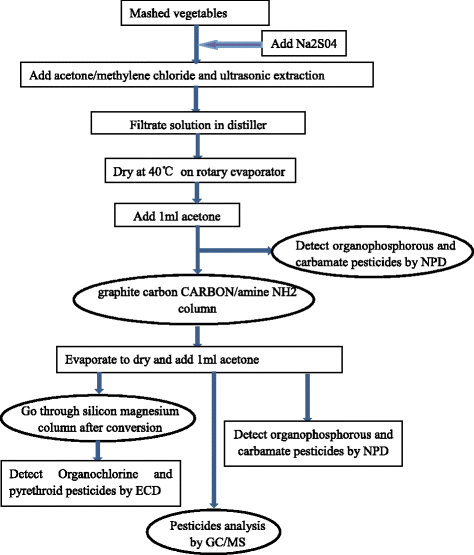Successive monitoring surveys of selected banned and restricted pesticide residues in vegetables from the northwest region of China from 2011 to 2013
- PMID: 28768508
- PMCID: PMC5541726
- DOI: 10.1186/s12889-017-4632-x
Successive monitoring surveys of selected banned and restricted pesticide residues in vegetables from the northwest region of China from 2011 to 2013
Erratum in
-
Erratum to: BMC Public Health, Vol. 18.BMC Public Health. 2017 Sep 22;17(1):736. doi: 10.1186/s12889-017-4709-6. BMC Public Health. 2017. PMID: 28938882 Free PMC article. No abstract available.
Abstract
Background: A wide range of pesticides is applied for crop protection in vegetable cultivation in China. Regulation of pesticide maximum residue limits (MRLs) in vegetables is established but not fully enforced. And pesticide residues in vegetables were not well monitored. This study conducted the monitoring surveys from 2011 to 2013 to investigate the pesticides in vegetables in the northwest region of China.
Methods: A multi-residue gas chromatography/mass spectrometry method (GC/MS) was used in determination of pesticides in vegetable samples. The χ2 test was used to compare the concentration of pesticide residues.
Results: A total of 32 pesticide residues were detected in 518 samples from 20 types of vegetables in this study. 7.7% of the detected pesticide residues exceeded the MRLs. The percentages of residues that exceeded the MRLs for leafy, melon and fruit, and root vegetables were 11.2%, 5.1%, and 1.6%, respectively. There was no seasonal difference in the proportion of samples that exceeded the MRLs in different vegetables. A total of 84.3% (27/32) pesticides were detected at concentrations that exceeded MRLs. And of the 27 pesticides that exceeded the MRLs, 11 (40.7%) were banned for use in agriculture. The most frequently detected pesticides were Malathion (9.4%), Dichlorvos (8.7%), and Dimethoate (8.1%).
Conclusion: The observed high rate of pesticides detected and high incidence of pesticide detection exceeding their MRLs in the commonly consumed vegetables indicated that the Good Agricultural Practices (GAP) may not be well followed. The management of pesticide use and control should be improved. Well-developed training programs should be initiated to improve pesticide application knowledge for farmers.
Keywords: MRLs; Pesticides; Residues; Vegetables.
Conflict of interest statement
Ethics approval and consent to participate
Not applicable.
Consent for publication
Not applicable.
Competing interests
The authors declare that they have no competing interests.
Publisher’s Note
Springer Nature remains neutral with regard to jurisdictional claims in published maps and institutional affiliations.
Figures
References
-
- Chinese Nutrition Society. The Chinese Dietary Guidelines (2016). 2016. http://dg.cnsoc.org. Accessed 13 May 2016.
-
- Yu R, Liu Q, Liu JS, Wang QC, Wang Y. Concentrations of organophosphorus pesticides in fresh vegetables and related human health risk assessment in Changchun. Northeast China FOOD CONTROL. 2016;60:353–360. doi: 10.1016/j.foodcont.2015.08.013. - DOI
-
- Park DW, Kim KG, Choi EA, Kang GR, Kim TS, Yang YS, et al. Pesticide residues in leafy vegetables, stalk and stem vegetables from South Korea: a long-term study on safety and health risk assessment. Food Addit Contam Part A Chem Anal Control Expo Risk Assess. 2016;33:105–118. - PubMed
MeSH terms
Substances
LinkOut - more resources
Full Text Sources
Other Literature Sources
Miscellaneous


